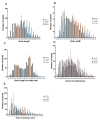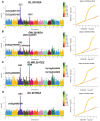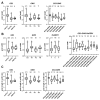Identification and Allele Combination Analysis of Rice Grain Shape-Related Genes by Genome-Wide Association Study
- PMID: 35162989
- PMCID: PMC8835367
- DOI: 10.3390/ijms23031065
Identification and Allele Combination Analysis of Rice Grain Shape-Related Genes by Genome-Wide Association Study
Abstract
Grain shape is an important agronomic character of rice, which affects the appearance, processing, and the edible quality. Screening and identifying more new genes associated with grain shape is beneficial to further understanding the genetic basis of grain shape and provides more gene resources for genetic breeding. This study has a natural population containing 623 indica rice cultivars. Genome-wide association studies/GWAS of several traits related to grain shape (grain length/GL, grain width/GW, grain length to width ratio/GLWR, grain circumferences/GC, and grain size/grain area/GS) were conducted by combining phenotypic data from four environments and the second-generation resequencing data, which have identified 39 important Quantitative trait locus/QTLs. We analyzed the 39 QTLs using three methods: gene-based association analysis, haplotype analysis, and functional annotation and identified three cloned genes (GS3, GW5, OsDER1) and seven new candidate genes in the candidate interval. At the same time, to effectively utilize the genes in the grain shape-related gene bank, we have also analyzed the allelic combinations of the three cloned genes. Finally, the extreme allele combination corresponding to each trait was found through statistical analysis. This study's novel candidate genes and allele combinations will provide a valuable reference for future breeding work.
Keywords: GWAS; allele combination analysis; gene-based association analysis; grain shape; haplotype analysis.
Conflict of interest statement
The authors declare no conflict of interest.
Figures








Similar articles
-
Genome wide association mapping for grain shape traits in indica rice.Planta. 2016 Oct;244(4):819-30. doi: 10.1007/s00425-016-2548-9. Epub 2016 May 19. Planta. 2016. PMID: 27198135 Free PMC article.
-
Candidate gene analysis of rice grain shape based on genome-wide association study.Theor Appl Genet. 2024 Sep 29;137(10):241. doi: 10.1007/s00122-024-04724-8. Theor Appl Genet. 2024. PMID: 39342533
-
Genome-wide association study reveals the advantaged genes regulating japonica rice grain shape traits in northern China.PeerJ. 2024 Dec 18;12:e18746. doi: 10.7717/peerj.18746. eCollection 2024. PeerJ. 2024. PMID: 39713157 Free PMC article.
-
Grain Size Associated Genes and the Molecular Regulatory Mechanism in Rice.Int J Mol Sci. 2022 Mar 15;23(6):3169. doi: 10.3390/ijms23063169. Int J Mol Sci. 2022. PMID: 35328589 Free PMC article. Review.
-
Genetic control of grain appearance quality in rice.Biotechnol Adv. 2022 Nov;60:108014. doi: 10.1016/j.biotechadv.2022.108014. Epub 2022 Jun 28. Biotechnol Adv. 2022. PMID: 35777622 Review.
Cited by
-
Multi-model genome-wide association studies for appearance quality in rice.Front Plant Sci. 2024 Jan 11;14:1304388. doi: 10.3389/fpls.2023.1304388. eCollection 2023. Front Plant Sci. 2024. PMID: 38273959 Free PMC article.
-
Analysis of Genetic Diversity in Adzuki Beans (Vigna angularis): Insights into Environmental Adaptation and Early Breeding Strategies for Yield Improvement.Plants (Basel). 2023 Dec 13;12(24):4154. doi: 10.3390/plants12244154. Plants (Basel). 2023. PMID: 38140482 Free PMC article.
-
Whole genome sequencing of ASD 16 and ADT 43 to identify predominant grain size and starch associated alleles in rice.Mol Biol Rep. 2022 Dec;49(12):11743-11754. doi: 10.1007/s11033-022-07935-8. Epub 2022 Oct 6. Mol Biol Rep. 2022. PMID: 36201102
-
Association Mapping and Expression Analysis of the Genes Involved in the Wood Formation of Poplar.Int J Mol Sci. 2023 Aug 10;24(16):12662. doi: 10.3390/ijms241612662. Int J Mol Sci. 2023. PMID: 37628843 Free PMC article.
-
Genome-Wide Association Study Identified Candidate Genes for Alkalinity Tolerance in Rice.Plants (Basel). 2023 Jun 3;12(11):2206. doi: 10.3390/plants12112206. Plants (Basel). 2023. PMID: 37299185 Free PMC article.
References
-
- Redoña E.D., Mackill D.J. Quantitative trait locus analysis for rice panicle and grain characteristics. Theor. Appl. Genet. 1998;96:957–963. doi: 10.1007/s001220050826. - DOI
MeSH terms
Grants and funding
LinkOut - more resources
Full Text Sources
Miscellaneous

